Crews Hole White House
"A landmark around which there are woven
many tales of romance and adventure"
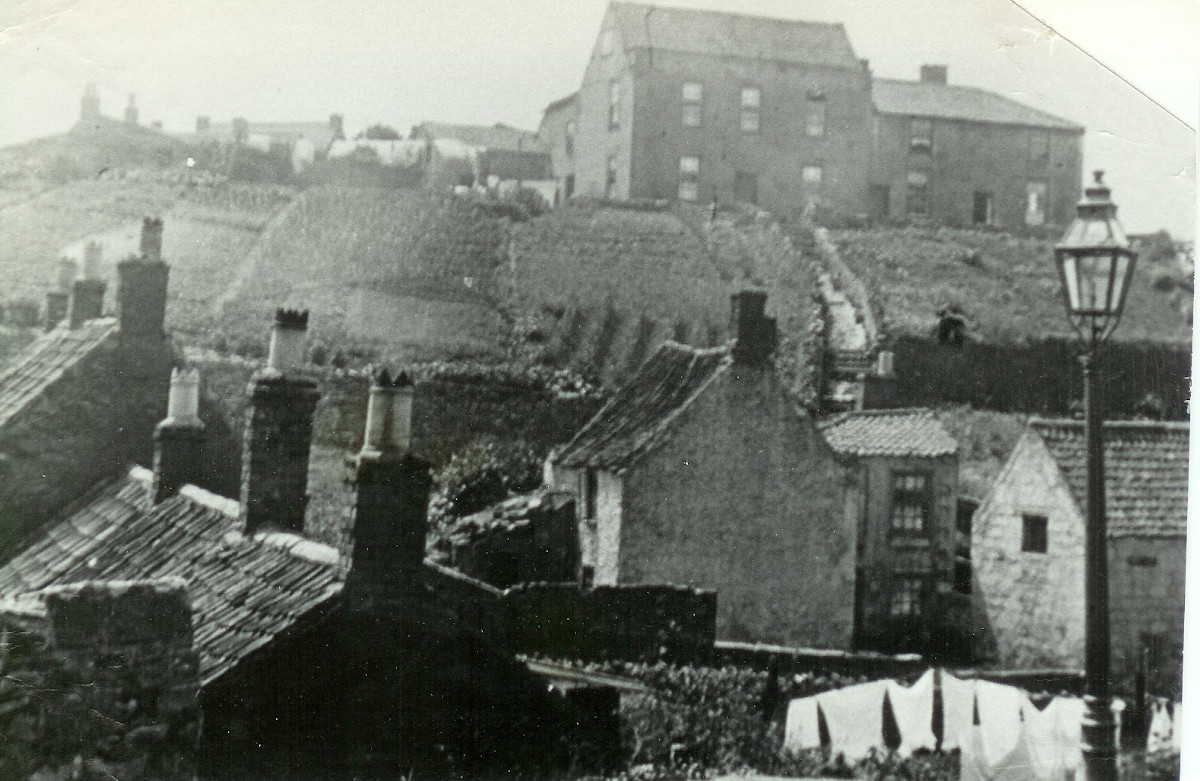
Above: Dr Fryer’s picture of “The White House” which was featured in an 'Images of England' Book of Crews Hole, St George and Speedwell by Dave Stephenson and other members of the Barton Hill History Group. Our thanks to Hanham Local History Society for scanning the original for us.
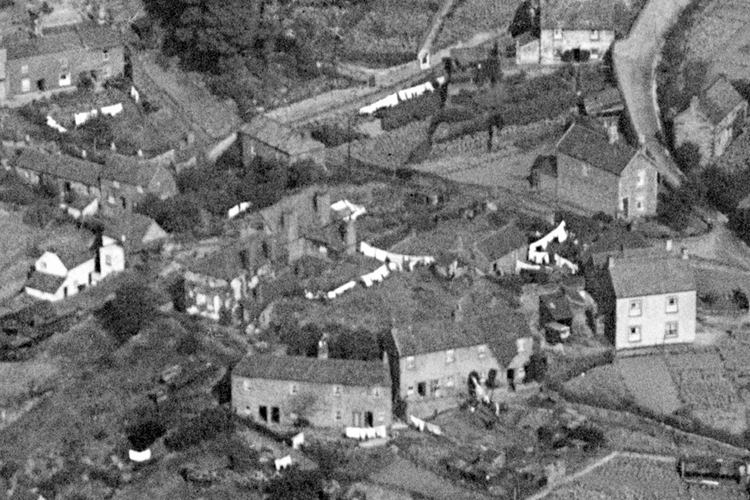 The 'White House' stood where there are now modern houses on Corkers Hill, Crews Hole.
The 'White House' stood where there are now modern houses on Corkers Hill, Crews Hole.
This 1926 'Britain from Above' photo (© Historic England and used under licence) shows the other side of the buildings from the photo above and from this view you can also see the large chimneys.
It can be seen that they were imposing buildings, with the western half having a lower roof line.
In 1939 they were described as "a substantially-built building reputed to be hundreds of years old".
On older maps the area between Troopers Hill and Nibletts Hill was refered to as 'White's Hill' and there was a 'Whiteshill Farm' near what is now the Kingsway, but it not known whether this is linked to the 'White House'.
The White House in the 1890s
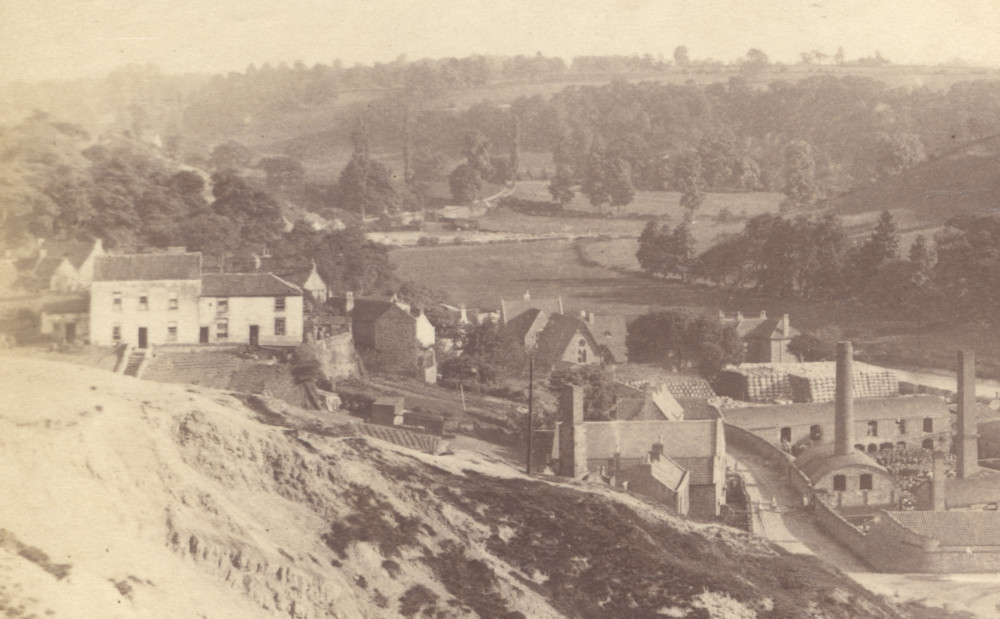
The above photograph is cropped from a view of Butlers' Tar Works taken from Troopers Hill in the 1890s. The full photograph and others from the same family album can be seen here.
The White House is at the left of the photo. The retaining wall to the right of the building still stands.
To the right of the photo are buildings and chimneys of the Tar Works and you can make out figures standing on Crews Hole Road.
The square chimney at the bottom of Troopers Hill is also visible, this was the site of a coal mine (closed by this date). Note that the lower part of the chimney is hidden by the Hill, so we must be looking at the second and now missing third top section of the chimney which was built in brick.
Behind the chimney is the Crews Hole Methodist chapel which opened in 1853, with strong support from William Butler. This has now been converted for residential use. As described below, until this chapel was built, part of the White House was used as a Wesleyan Methodist Chapel.
Residents - The Bessell Family
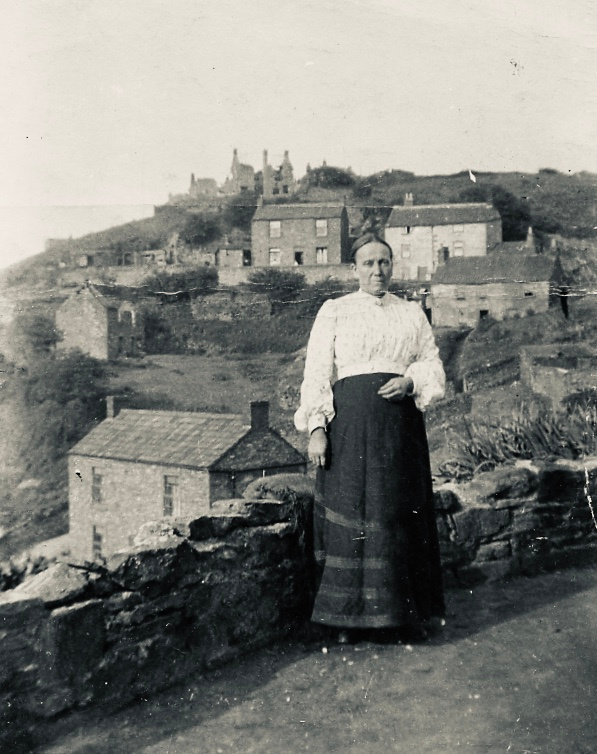 One of the residents of the White House in the early 1900s was Elizabeth Bessell, this photo shows her outside her home in around 1910. It was sent to us by her great-great-grand-daughter, Jayne.
One of the residents of the White House in the early 1900s was Elizabeth Bessell, this photo shows her outside her home in around 1910. It was sent to us by her great-great-grand-daughter, Jayne.
Some of the cottages that can be seen in the background are still standing and the view is recognisable from the garden of one of the modern houses. Some of the same cottages can be seen in the third of these images taken from Butlers Tar Works in 1953.
Elizabeth's daughter-in-law, Rose Bessell, née Amphlett, features in our photograph of the Crews Hole Women's Bright Hour group at Crews Hole Methodist Chapel.
Below are two more photos of the Bessell family in the garden of the White House, these were taken in around 1914.
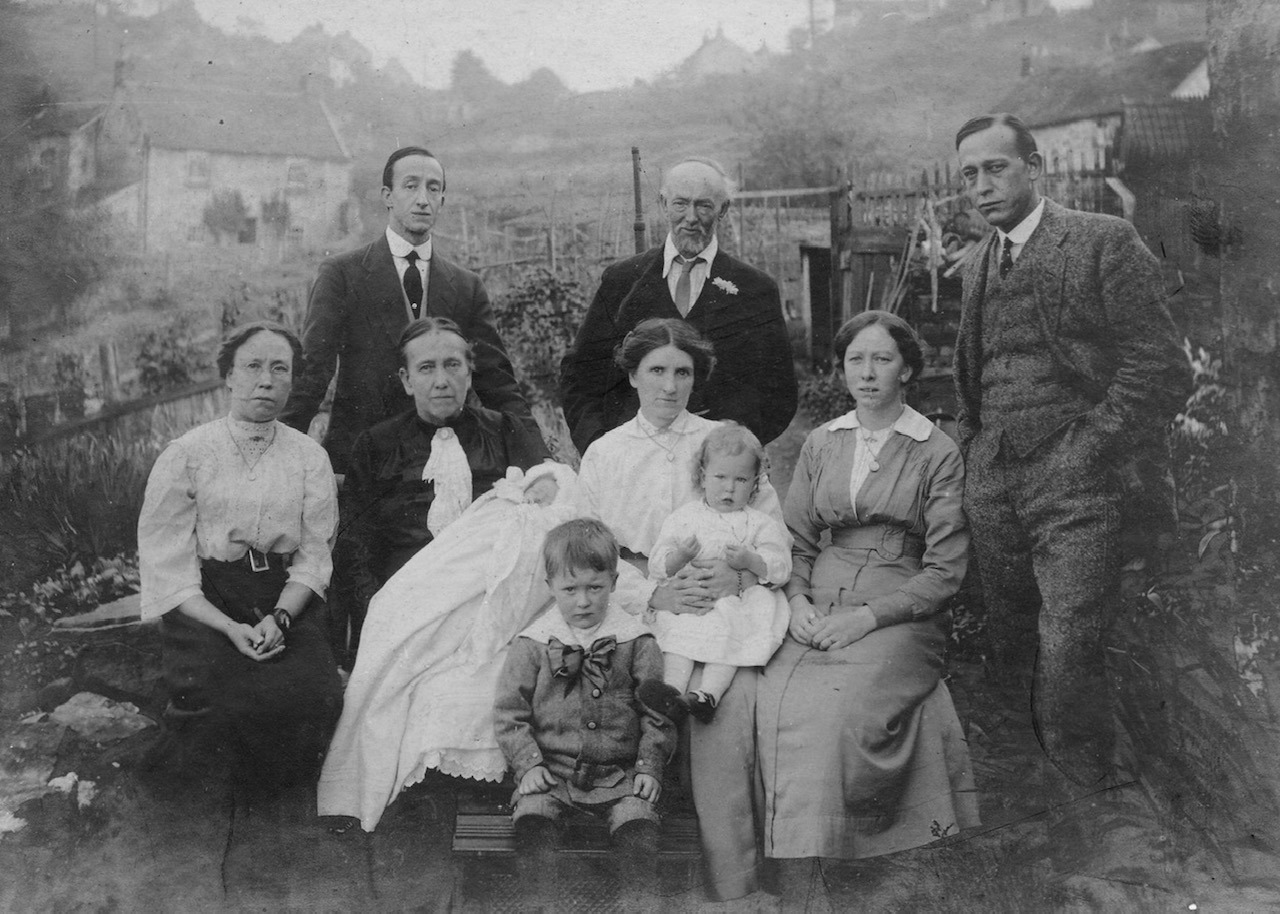
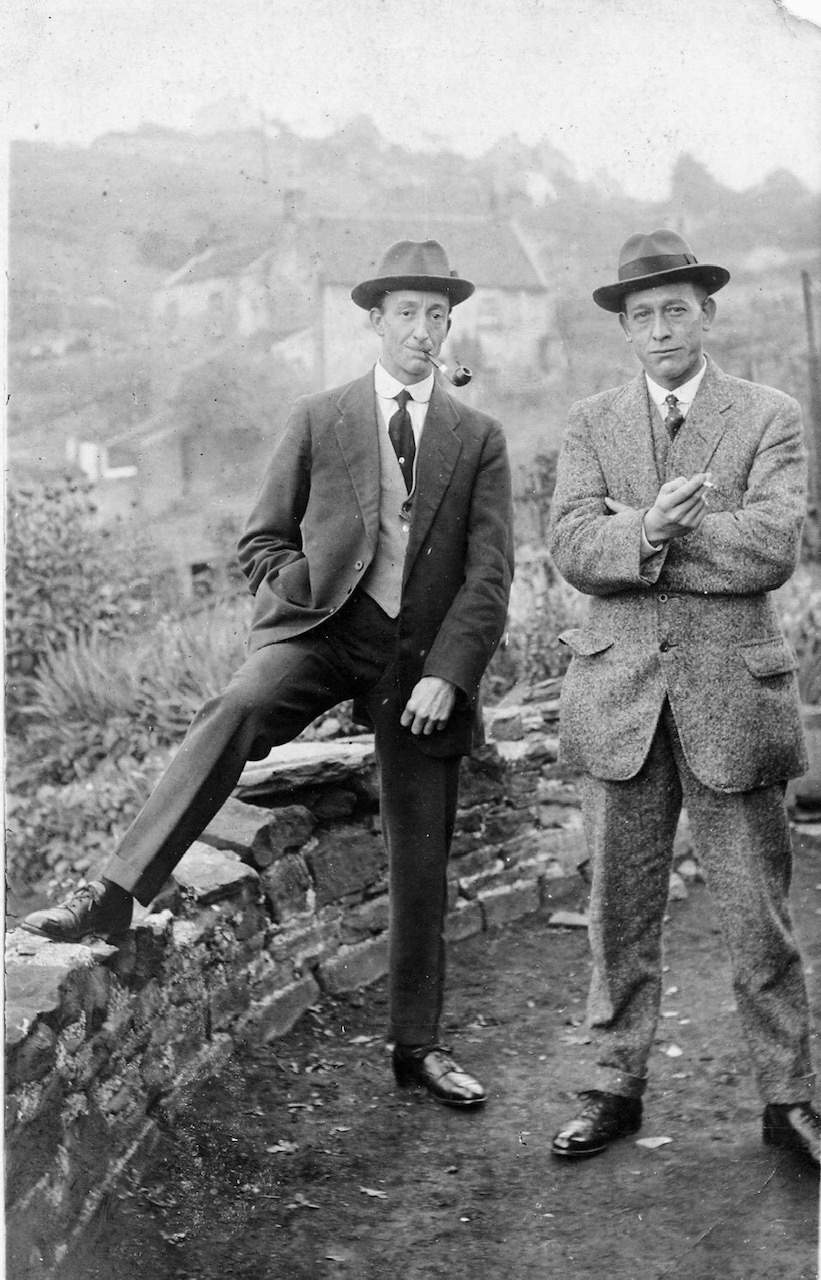 Above: Fred, John and William Bessell standing.
Above: Fred, John and William Bessell standing.
Next row, ?sister 1 Elizabeth, Rose and ?sister 2
John (Jack) in the middle at the front with his sisters Ivy to the right and Gwen to the left.
Right: William Bessell on the right with his brother Fred in almost the same spot.
John was Elizabeth Bessell's husband, Fred & William were their two sons. Jack, Ivy & Gwen were William & Rose's children.
The cottage in the background of these two photos was at the corner of Parfitt's Hill steps and Niblett's Hill but has also been replaced by modern buildings.
Residents - James Limb
The probate papers of James Limb (1797-1879) detail him as Workman at lead works and late of the White House in St George. His death at the White House, aged 83, on 20th December 1879 was reported in Western Daily Press on 26th December that year.
James was born in Derbyshire, he was a lead smelter on the Mendips then in Devonshire before he moved to Crews Hole, presumably he worked at Blackswarth Lead Works which was at the western end of Crews Hole.
It seems likely that James worked for, or had some connection with, Dr Benjamin Somers who purchased Troopers Hill and the old cooper smelting site by the river in 1828. Dr Somers who was shown as the occupier of part of the Blackswarth Lead Works in 1840; had interests in lead smelting in the Mendips was also involved briefly with The Tamar Smelting Works in Devon at a time when James and his family were living there according to the 1841 census.
James married his first wife Sarah Gully (of Rowberrow in the Mendips) in 1823 - their eldest child was baptised at the wedding! Their second daughter Sarah Jane was born in 1825. Sadly James' wife Sarah died within a few years of their daughter's birth. In 1828 he married his second wife Elizabeth Gully (Sarah's sister) following the birth of their first daughter Mary earlier that year. The family became a large one with 10 children altogether.
James' third son was James Walter Albert Limb, born 1836 in Burrington (the area where Dr Somers lived and worked), who later became the publican of the Hit or Miss Beerhouse in Crews Hole and is recorded there in the 1871 & 1881 census. He also had a son named James Walter Albert Limb (born 1861) who was recorded in the 1911 census as living at the Hit or Miss Cottage in Crews Hole with his family.
There is a family story that at one time the first James Limb (born 1797) was Steward at the White House. He was waiting at table one day when his employer remarked "I shall remember you, Limb" (meaning to remember him in his will) when he fell forward dead. James Limb never received a penny. A further story tells of the White House being associated with fine music which drew crowds on Sundays!
Thank you to Sue White, Great Great Grandaughter of the first James Limb, for sharing the above information.
Sue has no known connection with the later White family owners.
Place of Worship
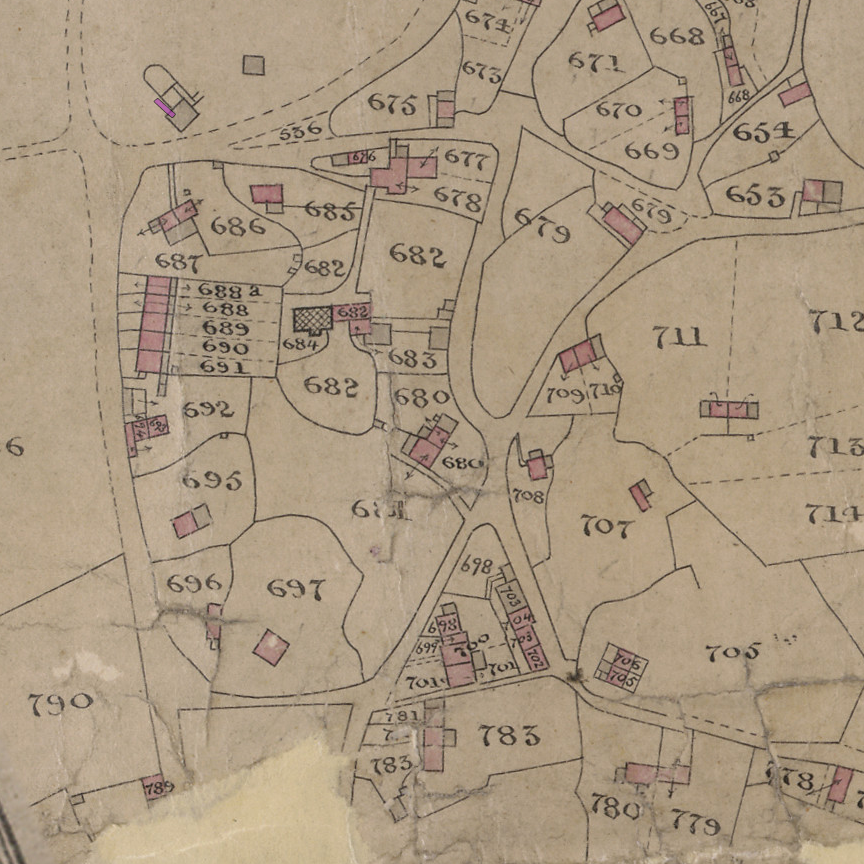 This extract from the 1840s tithe map of St George (taken from Bristol City Council Know Your Place maps) shows the White House as plots 684, 683 & 682. You can see the cross hatching on the western part of the building (plot 684), this hatching is used to denote religious buildings.
This extract from the 1840s tithe map of St George (taken from Bristol City Council Know Your Place maps) shows the White House as plots 684, 683 & 682. You can see the cross hatching on the western part of the building (plot 684), this hatching is used to denote religious buildings.
The Tithe Apportionment Index shows that plot 684, was a Methodist Meeting House in the ownership of Rev Robert Smith.
Rev Robert Smith was a Governor and Treasurer at the Wesleyan's school at Kingswood (which later moved to Bath). His ownership of this, and other chapels in the area, was likely in this official capacity, rather than as an individual.
The reference to James Limb being a Steward at the White House (see above) may well therefore refer to his role at the chapel as this is a recognised role in the Methodist Church.
It seems that the western half of the White House was the Meeting House for the Crews Hole Wesleyan Methodist congregation.
As described in our page about the Free Methodist Chapel on Crews Hole Road, a split occured in the Wesleyan Methodist church in 1849. This makes it difficult to know exactly when the White House Chapel ceased to be used.
In the late 1840s the intention was that the a new chapel was to be built on Crews Hole Road to replace the White House building and William Butler of the Tar Works, as a member of the Wesleyan Methodists, was likely involved in this.
However, the original Wesleyan Church (with smaller congregations after the split) ended up selling the new chapel to what became the United Methodist Free Church in 1853.
The Gloucestershire Places of Worship website has a page about Crews Hole Methodist Chapel this includes a reference to the "White House Chapel" at Crews Hole, St George as being in use in 1851, and also a separate Wesleyan Chapel in Crews Hole, so it seems both were in use at that date - presumably by the separate branches of the church.
The Wesleyans built a new chapel by the river in Crews Hole in 1860, it is possible that the White House chapel remained in use until this was opened.
Following the closure of the Crews Hole Chapel in 1987, its congregation joined that of the newly built Summerhill Methodist Church, in Summerhill Road. That church is where Friends of Troopers Hill held their meetings from 2010 until the Covid pandemic in 2020; due to a diminishing congregation the church closed in the summer of 2022.
Stories from Crew's Hold - Elizabeth Emra
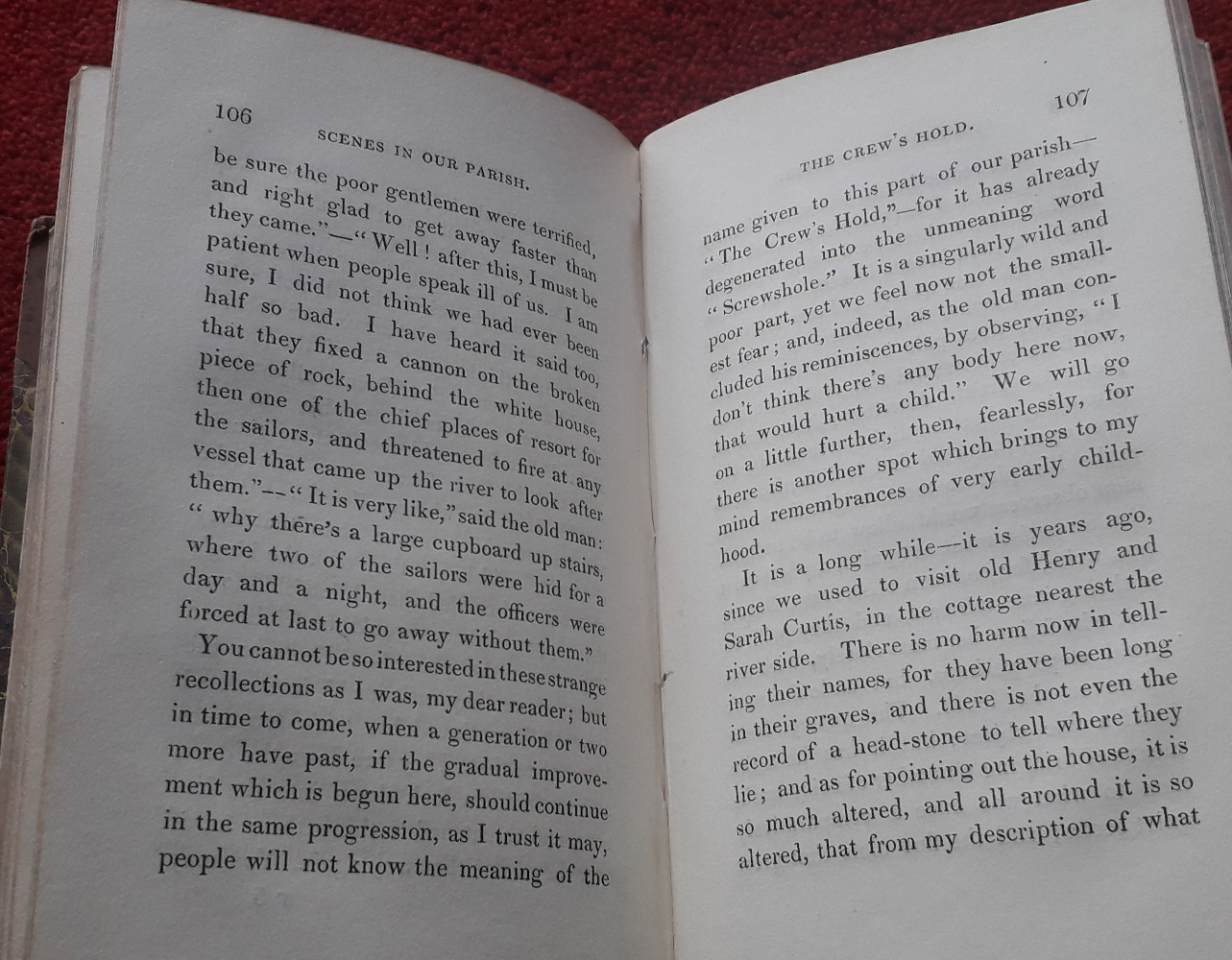 Writing in 1831, Elizabeth Emra, mentions the 'white house' in the 'Crew's Hold' chapter of 'Scenes in our Parish' - read more about Elizabeth Emra and this wonderful book here.
Writing in 1831, Elizabeth Emra, mentions the 'white house' in the 'Crew's Hold' chapter of 'Scenes in our Parish' - read more about Elizabeth Emra and this wonderful book here.
Elizabeth describes a visit to 'Old Thomas' who lived in 'Crew's Hold' and some of the stories he told. Elizabeth asks "Do you recollect how the sailors used to come up here to hide from the press gang?".
Thomas replies
"the people for the most part, liked the sailors, and used the officers of the press-gang very ill"
Elizabeth: "I have heard about taking them down the coal-pits"
Old Thomas: "I'll tell ye something worse than that they did once, they took the king’s officers and carried them blindfold down the copper furnace"
Elizabeth then adds: "I have heard it said too that they fixed a cannon on the broken piece of rock, behind the
white house, then one of the chief places of resort for the sailors, and threatened to fire at any
vessel that came up the river to look after them".
Old Thomas replies "It is very like, why there’s a large cupboard, upstairs, where two of the sailors were hid
for a day and a night, and the officers were forced, at last, to go away without them"
The story then moves on to a visit to old Henry and Sarah Curtis, and we are told that Sarah "had once lived in a larger abode, having many years before we knew her been mistress of the white house - the resort of the rebellious sailors of which I spoke just now". Elizabeth notes that "There is no harm now in telling their names, for they have long been in their graves, and there is not even the record of a head-stone to tell where they lay.
There is a record of a Henry Curtis (born 1746) of Crews Hole being buried on 11th November 1821 in St George and also of the burial of Sarah Curtis on 18th April 1824 also in St George. It is possible that these are the Henry and Sarah that Elizabeth knew and that she was indeed using their real names.
Crew's Hole / Hold - Origin of the Name?
At the celebrations for the laying of the foundation stone for the Wesleyan Chapel in Crews Hole (reported by the Western Daily Press 11 September 1860) the White House was mentioned as the source of the name "Crew's Hole".
"the Chairman explained the origin of the curious name of the river-side village known as "Crews Hole." The place had some romance about it. Many years ago, when things were arranged differently to what they are under Her Gracious Majesty - when manning the navy was acheived by the means of a press-gang - there was a place on the hill known as the White House, which had a back door as well as a front; and when men did not desire to fall into the hands of the rough personages composing the press-gang they were often able to excape through the back door. Hence the place was called "Crews Hole or rather "Crew's Hold." (Applause.)"
Bristol Landmark Disappears
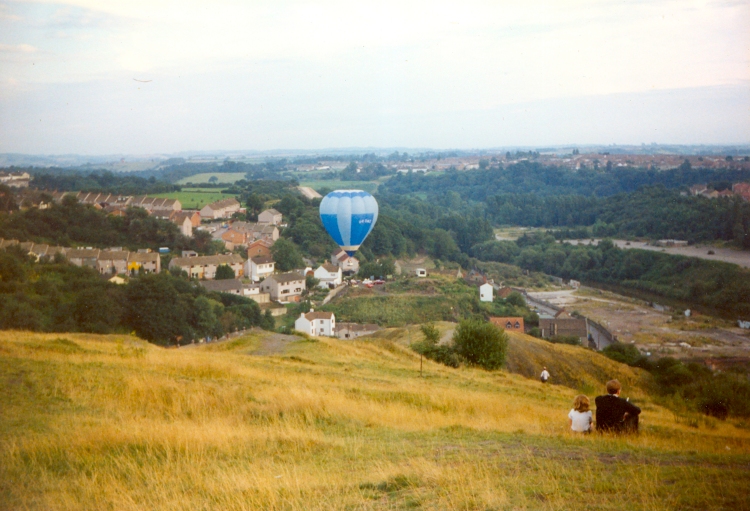 The White House was demolished in 1939 and the site remained vacant until 1993, it can be seen below the balloon in this photo from 17th August 1985 that is included in one of our sets of old photographs.
The White House was demolished in 1939 and the site remained vacant until 1993, it can be seen below the balloon in this photo from 17th August 1985 that is included in one of our sets of old photographs.
Its demolition was reported in the Bristol Evening Post on 17th January 1939, the report (found in the British Newspaper Archive) under the heading "Bristol Landmark Disappearing" also includes some comments about the building's history:
"A landmark around which are woven many tales of romance and adventure in the Crews Hole district of St. George is fast disappearing.
The White House, a substantially-built building reputed to be hundreds of years old, has been condemened as unfit for human habitation and a demolition gang is fast pulling it to pieces.
On the steep hillside overlooking the river it is reputed to have been at one time the haunt of smugglers and pirates, and tradition has it that there was formerly a secret underground passage leading from its cellars to the riverside.
Old-time newspapers definitely associate the building with privateering, for an advertisement invites seamen and ablebodied landsmen to try their fortunes in the ship Alexander "for Cadiz and to cruise four months.
Applicants to join in her venture were invited to meet Capt. Olive at the Royal Exchange or at the White House, Crews Hole, Kingswood.
The man who is in charge of the demolition work is the owner, Mr William White, to whom the house was left by his grandfather"
William White's grandfather was Charles White who had died in 1895. Charles White had bought the White House at auction for the sum of £250 on 28th Sept 1880. The four dwellings were rented out and the family made several attempts to sell, including in an auction in 1910 where the residents were noted as 'Messrs Boon, Bessell, McKinley, and another'.
The advert for the 1880 auction at which Charles White bought the four dwellings described:
"All those Four substantially built and commodious cottages with gardens and a stable and outhouse known as the WHITEHOUSE."
So the name White House appears to have been a coincidence and not connected to the White family.
The advert also referred to the fact that is was "within an easy distance of the Tramways" and added that they were "In the occupation of Old Tenants at very inadequate weekly rents".
Redevelopment
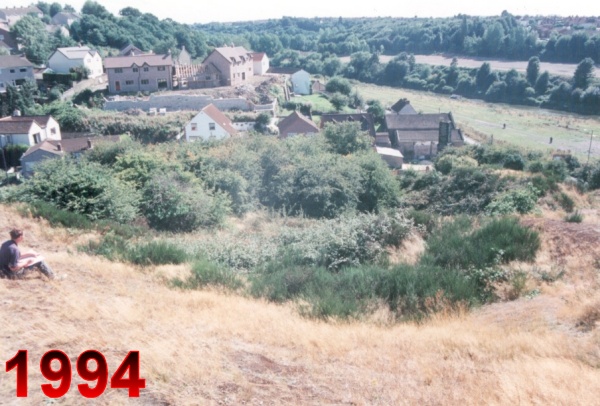 The land was not all finally sold by the estate of Charles White until 1984 when a final distribution of funds was made to his descendents.
The land was not all finally sold by the estate of Charles White until 1984 when a final distribution of funds was made to his descendents.
The final stages of the construction of the new houses on the plot was captured in this view from the Hill which forms part of our photo survey.
One of the houses on the site is now occupied by the Chair of Friends of Troopers Hill, Susan, and her husband Rob.
If you have any other information about the White House (or old photographs) please contact us we are keen to learn more about its history and residents.

 The 'White House' stood where there are now modern houses on Corkers Hill, Crews Hole.
The 'White House' stood where there are now modern houses on Corkers Hill, Crews Hole. The story of the Crews Hole White House is also featured on the Bridging Histories website:
The story of the Crews Hole White House is also featured on the Bridging Histories website:
 One of the residents of the White House in the early 1900s was Elizabeth Bessell, this photo shows her outside her home in around 1910. It was sent to us by her great-great-grand-daughter, Jayne.
One of the residents of the White House in the early 1900s was Elizabeth Bessell, this photo shows her outside her home in around 1910. It was sent to us by her great-great-grand-daughter, Jayne.

 Above: Fred, John and William Bessell standing.
Above: Fred, John and William Bessell standing. This extract from the 1840s tithe map of St George (taken from Bristol City Council Know Your Place maps) shows the White House as plots 684, 683 & 682. You can see the cross hatching on the western part of the building (plot 684), this hatching is used to denote religious buildings.
This extract from the 1840s tithe map of St George (taken from Bristol City Council Know Your Place maps) shows the White House as plots 684, 683 & 682. You can see the cross hatching on the western part of the building (plot 684), this hatching is used to denote religious buildings. Writing in 1831, Elizabeth Emra, mentions the 'white house' in the 'Crew's Hold' chapter of 'Scenes in our Parish' - read more about Elizabeth Emra and this wonderful book here.
Writing in 1831, Elizabeth Emra, mentions the 'white house' in the 'Crew's Hold' chapter of 'Scenes in our Parish' - read more about Elizabeth Emra and this wonderful book here.
 The White House was demolished in 1939 and the site remained vacant until 1993, it can be seen below the balloon in this photo from 17th August 1985 that is included in one of our sets of old photographs.
The White House was demolished in 1939 and the site remained vacant until 1993, it can be seen below the balloon in this photo from 17th August 1985 that is included in one of our sets of old photographs.
 The land was not all finally sold by the estate of Charles White until 1984 when a final distribution of funds was made to his descendents.
The land was not all finally sold by the estate of Charles White until 1984 when a final distribution of funds was made to his descendents.